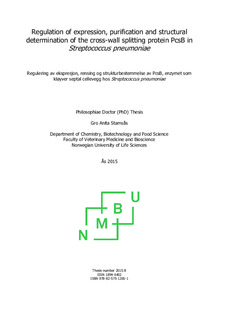| dc.contributor.advisor | Håvarstein, Leiv Sigve | |
| dc.contributor.advisor | Straume, Daniel | |
| dc.contributor.author | Stamsås, Gro Anita | |
| dc.date.accessioned | 2018-04-24T12:39:57Z | |
| dc.date.available | 2018-04-24T12:39:57Z | |
| dc.date.issued | 2018-04-24 | |
| dc.identifier.isbn | 978-82-575-1265-1 | |
| dc.identifier.issn | 1894-6402 | |
| dc.identifier.uri | http://hdl.handle.net/11250/2495740 | |
| dc.description.abstract | The human pathogen Streptococcus pneumoniae causes approximately 1.6 million deaths per year. Hence, it is of great concern that the bacterium`s resistance against antibiotics has increased dramatically in recent decades. If this development continues, currently prescribed antibiotics might become useless. For this reason, it is important to identify new drug targets and antibiotics that can be used to fight pneumococcal infections. The cell wall synthesis machinery and the cell division apparatus are attractive targets for development of new antimicrobial agents. However, much remains to be learned about these processes in S. pneumoniae and other bacteria. Further research on bacterial cell division and cell wall synthesis is therefore needed.
The integrity of the cell wall protects bacterial cells from turgor pressure-induced lysis during cell division. The synthesis and splitting of the new cross wall are two operations that must be carefully coordinated. The two-component regulatory system WalRK is believed to play a central coordinating role in these processes. The gene pcsB, which is under WalRK control, encodes an enzyme that has been predicted to split the septal cross wall during cell division. | nb_NO |
| dc.description.abstract | Den humanpatogene Streptococcus pneumoniae forårsaker omtrent 1,6 millioner dødsfall hvert år. Derfor er det knyttet stor bekymring til at bakteriens resistens mot antibiotika har økt dramatisk de siste tiårene. Dersom denne utviklingen fortsetter vil trolig dagens antibiotika ikke lenger fungere. For å kunne behandle infeksjoner forårsaket av bakterien i fremtiden, er det derfor viktig å identifisere nye mål for antibiotika. Cellevegg-syntesemaskineriet og celledelingsapparatet er attraktive mål i utviklingen av nye antibiotika. Dessverre er disse prosessene fremdeles dårlig karakterisert i S. pneumoniae og i andre bakterier. Derfor trengs det mer forskning på celledeling og celleveggsyntese i bakterier. Celleveggen beskytter bakteriene fra lysis forårsaket av turgor trykket under celledeling. Derfor må syntese og kløyving av septal cellevegg være to finkoordinerte prosesser. To-komponent systemet WalRK spiller trolig en sentral rolle i denne koordineringen. Genet pcsB, som er regulert av WalRK, koder for et enzym som er antatt å kløyve septal cellevegg under celledeling. | nb_NO |
| dc.language.iso | eng | nb_NO |
| dc.publisher | Norwegian University of Life Sciences, Ås | |
| dc.relation.ispartofseries | PhD Thesis;2015:8 | |
| dc.title | Regulation of expression, purification and structural determination of the cross-wall splitting protein PcsB in Streptococcus pneumoniae | nb_NO |
| dc.title.alternative | Regulering av ekspresjon, rensing og strukturbestemmelse av PcsB, enzymet som kløyver septal cellevegg hos Streptococcus pneumoniae | nb_NO |
| dc.type | Doctoral thesis | nb_NO |
| dc.source.pagenumber | 145 | nb_NO |
